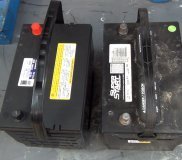Definitely. There's three different engines and they all have very different systems. First of all, try holding the gas pedal down just 1/4" during cranking to see if it starts. (More is not better; just 1/4"). If it starts and if it stays running as long as you hold the gas pedal down a little, we have to look at the automatic idle speed motor. Based on that code, I'd suspect a corroded terminal in its connector. Failure inside the motor itself is rare because to set that code there would have to be two broken wires at the same time.
The alternator code is not related to a no-start condition. We can look into that one later once the engine is running.
I've never run into that ASD code before so instead of worrying about that one right now, start by checking for spark while a helper cranks the engine. If spark is missing, we have to check if the ASD relay is turning on during cranking. To test for that, use a test light or voltmeter to check for 12 volts at the ignition coil pack, any injector, or either small wire on the back of the alternator. I don't remember the wire color but there will be one wire at each injector and at the coil pack that is the same. On newer cars it is dark green with an orange stripe. You should see 12 volts there for just one second after turning on the ignition switch. You may hear the hum of the fuel pump for that one second and you may hear a hiss from the fuel pressure regulator on the front passenger side of the engine. If any of that occurs, the ASD relay is okay and the Engine Computer has control of it. I doubt the relay is bad based on how the events of the failure occurred.
What is important is that 12 volts must come back during cranking. If it does not, suspect the crankshaft position sensor. They commonly fail when they get hot and work again after they cool down for an hour or two. A no-start after stopping at a gas station or grocery store is one of the most common problems caused by crank sensors.
Normally there would be a diagnostic fault code related to that sensor but not always when the problem doesn't occur while driving. The camshaft position sensor can cause a no-start too but it has a much lower failure rate.
If you do have spark, try to listen for the hum of the fuel pump. If you don't hear it for that first one second after turning on the ignition switch, try banging on the bottom of the gas tank to jar it. GM fuel pumps typical fail while driving and they let you sit on the side of the road in a puddle of tears. Chrysler pumps never quit once they're running. With high mileage they WILL intermittently fail to start up due to worn brushes in the pump motor. Banging on the gas tank is a common and often effective way to get them started. When they do finally start, it could be weeks or months before that happens again, but it gave you warning that failure is imminent.
Saturday, June 30th, 2012 AT 7:41 AM



